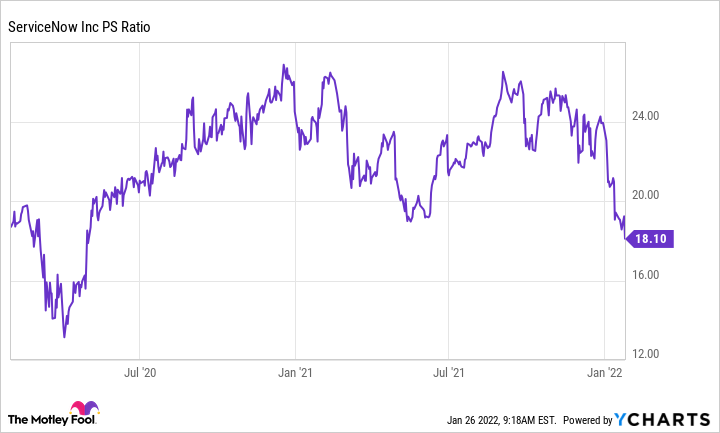The stock market is shedding value thus far in 2022. Inflation, tapering, and expected interest rate hikes have rattled investors. Many tech companies are bearing the brunt of the hit. When the market sells off, it creates opportunities to buy quality companies on sale. This may be the case with ServiceNow (NOW 1.02%).
ServiceNow is a software-as-a-service (SaaS) company that provides digital workflow solutions to clients. The company offers workflow platforms for IT, HR, customers, and creators. Delivering solutions that increase productivity for businesses is the name of the game. This is why the company boasts 6,900 customers, including 80% of the Fortune 500.

Source: Getty Images
What happened?
ServiceNow has been an extremely successful stock over the last ten years. An investment of $10,000 10 years ago would be worth more than $200,000 today. However, as we can see below, the stock has dropped recently. In fact, it currently trades more than 25% down from its 52-week high.
ServiceNow, along with much of the technology sector, was flying high until late 2021, when cracks began forming in the market. When inflation breached 7%, it became clear that the Federal Reserve would have to increase the pace of tapering and raise interest rates several times in 2022. These rate hikes tend to hurt the value of growth and tech stocks, which are valued on their ability to generate future cash flows. Combine this with the market sentiment that valuations were stretched, investors locking in gains, and potential trouble on the Russia-Ukraine border, and the market could not sustain its upward momentum. When a general sell-off occurs, many quality stocks can go on sale.
This appears to be the case with ServiceNow. Since the March 2020 market crash related to COVID-19, the stock has generally traded at a price-to-sales (P/S) ratio over 20. Now, thanks to macroeconomic conditions, the stock is trading at a lower P/S ratio than just before the pandemic, as can be seen below.
NOW PS Ratio data by YCharts
The fundamentals remain strong
ServiceNow has some fantastic fundamentals that should impress investors. First, revenue is growing at a brisk pace. For the first nine months of 2021, the company posted $4.3 billion in sales. This is a 31% increase over the same period in 2020. Gross profit grew 29% to $3.3 billion over the same period. For the full year 2021, the company has guided for $5.6 billion in revenue, an increase of 30% over 2020. In addition, the company reports an impressive non-GAAP gross margin of 85% and a non-GAAP operating margin of 26%. These items suggest that the company is highly scalable and can continue to deliver impressive cash flows to shareholders. ServiceNow has delivered $1.3 billion in operating cash flows through the first nine months of 2021.
The company reports other encouraging metrics. Its remaining performance obligations (RPO) remain strong at $9.7 billion. RPO represents the total contract value of future performance obligations -- in other words, revenue that has yet to be earned but is under contract to be performed. Therefore, the higher the number, the better. This number has grown from $7.3 billion in Q3 2020 to $9.7 billion in Q3 2021. ServiceNow also reports a robust customer retention rate of 98%. This is a critical metric for a SaaS company. It spends heavily on sales and marketing to acquire new customers. Keeping 98% of them each year makes this investment well worth it.
Has ServiceNow become a buy?
Jitters have hit the market hard so far in 2022, and they may not be over. Uncertainty over Federal Reserve actions relating to inflation, international conflict, and a general feeling that market valuations are stretched are likely culprits. While many investors are selling, these conditions can prove beneficial for buyers in the long run. Many quality stocks are now trading at lower valuations than just before the pandemic market turmoil. This is the case with ServiceNow. The underlying business remains strong. Revenue is growing, along with RPO, and the company has a strong foothold among Fortune 500 customers. With the stock trading at a P/S ratio under 20 and 25% down from its 52-week high, it is an ideal time for investors to consider accumulating shares.







